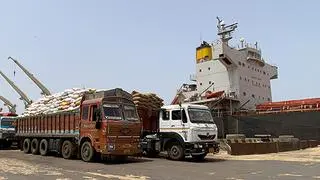Come autumn, and the National Capital Region ends up discussing stubble burning and ‘solutions’ to the issue. The Punjab government has suggested phasing out paddy cultivation in the State by incentivising farmers to grow millets. This is expected to check stubble burning as well as overuse of groundwater, which has already sunk to precarious levels in most parts of the State.
The Supreme Court has asked the Centre to consider this suggestion seriously, while agreeing with the assertion of the Advocate General of Punjab (AGP) that paddy cultivation has played havoc with the water table in the State. The Court too has asked the Centre to explore giving MSP for alternative crops like millets.
The arguments in the Supreme Court and the solutions discussed were along familiar lines. The first among these is — since MSP has led to rising paddy cultivation in Punjab. withdrawing MSP on Punjab paddy can resolve the imbalances. Second, MSP for alternative crops can help phase out paddy.
It is a widely held belief that MSP is a potent policy tool to bring about a shift in crop pattern from paddy to millets. But for this shift to happen, cultivating millets must be as remunerative as paddy and wheat.
Here, I remember my three-decade old interaction with a farmer from Rayalaseema, Andhra Pradesh on why he cultivated groundnut instead of ragi. He explained the relative economics of the two crops and proved that he could get almost thrice the net income by switching to groundnut.
Clearly, millet area has declined over the years due to rational choice of farmers. Across the country farmers quickly replaced millets and pulses in their cropping pattern with remunerative crops. A favourable price policy and higher investment in R&D for rice and wheat to tackle the food problem encouraged this shift.
The numbers
What is the situation with respect to millets output and cost today? Data for Telangana (2019-20) showed that output value per hectare of jowar, bajra and paddy was ₹25,003, ₹53,777 and ₹1,10,708, respectively. In relative terms, jowar and bajra output value per hectare was 23 per cent and 49 per cent of paddy output value, respectively. That is, lower millet productivity per hectare which is hardly 50 per cent of what rice, wheat or sugarcane can produce is the major factor working against millets.
Cost of cultivation (Cost A2) of jowar and bajra was about 45 per cent and 53 per cent of that of paddy (see table for absolute values). Even so, profitability are lower for these two crops as the table shows.
Millets may give even negative net returns depending on the rainfall. Low resource (water and fertilisers) needs for millets cannot outweigh its low profitability.
What does it take to promote jowar in a hectare? Our estimates (presented in our paper on Crop ‘Diversification in Telangana — A few Issues’ presented during 7th Annual Conference of Telangana Economic Association in February 2023) provide some revealing insights.
Based on cost of cultivation data for Telangana in 2019-20, we have shown that, relative to paddy, there can be substantial savings in fertiliser use (259 per cent for bajra and 409 per cent for jowar) and moderate gains in employment (30 per cent for bajra and 20 per cent for jowar), but loss of output (77 per cent for jowar and 52 per cent for bajra) and labour productivity (81 per cent for jowar and 63 per cent for bajra) can be huge that can threaten food security and reduce incomes of farmers and agricultural labour.
Jowar gave an income of ₹25,033 per hectare during 2019-20. Its price per ha must be fixed almost five times the prevailing average price of ₹2,897 to match with paddy’s income. That is, one must bring 4.42 ha of land under jowar to protect the present level of income, which is not feasible for a farmer.
In absolute terms, the government should transfer ₹85,657 to a paddy farmer per hectare of conversion to jowar. This sounds highly impractical. Also, the economy gets 52 quintals less of foodgrains for every hectare converted to jowar as the latter gives 7.88 quintals vs 60 quintals from paddy. These calculations hold good even for Punjab and other States where lucrative crops are being cultivated, for farmers are rational producers and choosing a cropping pattern is a zero-sum game.

What is the way out?
We can promote millets, which are nutritious and eco-friendly, but only in resource-poor, water-scarce areas where there is no other choice. We suggest mapping resource-poor blocks within such areas for millet promotion (millet blocks) instead of blanket recommendation across the country.
Declaring higher minimum support prices may not be practical and effective in expanding area under these crops. Income support may help though its implementation is challenging.
In fact, we can justify income support based on the ecosystem services millet crops provide through climate proofing and saving scarce resources. However, we should target these measures only to millet blocks.
Other measures like running campaigns, demand creation by including millets in Poshan Mission Abhiyan and Public Distribution System and supply side initiatives like encouraging millet value chains through Farmer Producer Organisations should be part of the package.
The writer is an agricultural economist and former CGM, Nabard








Comments
Comments have to be in English, and in full sentences. They cannot be abusive or personal. Please abide by our community guidelines for posting your comments.
We have migrated to a new commenting platform. If you are already a registered user of TheHindu Businessline and logged in, you may continue to engage with our articles. If you do not have an account please register and login to post comments. Users can access their older comments by logging into their accounts on Vuukle.